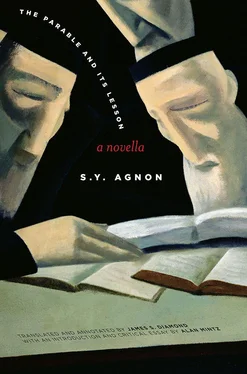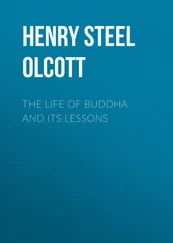15. The pedagogical passion for fashioning a mode of communication that is precisely fitted to his listeners is made the subject of an anecdote, a mashal of sorts, about a Jewish jeweler who is summoned to create gold earrings for the king’s daughter and takes special pains to adapt the ornament to the exact proportions of her ear (414).
16. Shulamit Almog argues that Rabbi Moshe does not make practical use of his eyewitness knowledge of Aaron’s death because he realizes that matters of Jewish law must be adjudicated according to evidence and procedures that are transparent and available to all. Despite the rabbi’s intense empathy for Zlateh, he knows that supernatural disclosures that he alone — together with the shamash — have been privy to cannot meet this standard of evidence. See Shulamit Almog, ‘Ir, mishpat, sipur [City, Law, Story] (Tel Aviv: Schocken, 2002), pp. 78–82.
17. Joshua Shanes, “Buchach,” YIVO Encyclopedia of Eastern Europe, http://www.yivoencyclopedia.org/article.aspx/Buchach; Martin Rudner, “Buczacz Origins,” http://www.ibiblio.org/yiddish/Places/Buczacz/bucz-p1.htm.
18. Literally, the persecutions of 5408 and 5409.
19. Shanes, ibid.
20. This is a rich theme in Agnon’s corpus. At the conclusion of Oreaḥ natah lalun [A Guest for the Night] the keys to the study house of Buczacz, which has been decimated by World War One, are transferred to Eretz Yisrael. In the opening, foundational story of ‘Ir umelo’ah (“Buczacz,” pp.9–13), the founding of the city is framed as a way station on an ascent to Eretz Yisrael that became permanent.
21. For a responsible overview of these issues with representative texts, see Simcha Paull Raphael, Jewish Views of the Afterlife (Northvale, NJ: Jason Aronson, 1994), especially chapter 6, “Visionary Tours of the Afterlife in Medieval Midrash,” pp. 163–232.
22. Qetsat qasheh , “a little difficult,” is a phrase that has its origins in the Tosafists’ commentary on the Talmud; it is used when the Tosafists find glaring contradictions or problems in Rashi’s commentary. It is a classic instance of understatement. Within a religious tradition based on the presumed authority of earlier teachers, the phrase is a delicate means of noting a major issue. See “Hasiman” [The Sign], 714, for an interesting parallel.
23. The other outstanding example of the overall narrator handing over the narration to a narrator dramatized within the story is “Ha’ish levush habadim” [The Linen Man, 84–121].
24. David Stern, Parables in Midrash: Narrative and Exegesis in Rabbinic Literature (Cambridge, MA: Harvard University Press, 1991).
25. This is wonderfully dramatized in the story “Genizah” by Devorah Baron, Parshiyot: sipurim mequbatsim [Collected Stories] (Jerusalem: Bialik Institute, 1951), pp. 236–245. Also note to pp.424–425, where the shamash digresses on the rabbi’s championing the mashal as a homiletic tool superior to the rhetoric of reproach (tokheḥah). It is worth noting that the narrator intervenes immediately after this remark to point out that midrash collections were scarce in the rabbi’s time, whereas today all recognize the worth of the mashal. In the story “Hamevakshim lahem rav” in ‘Ir umelo’ah , a letter of rabbinic appointment specifies the obligation to include aggadah and meshalim in public homilies in anticipation of an inclination of scholarly rabbis to speak only of matters of halakhah.
26. In the very first story in ‘Ir umelo’ah , “Buczacz,” the founding of the city is presented as resulting from an arrested pilgrimage to the Land of Israel.
Agunah Literally a “chained woman”; a woman who cannot remarry because her husband will not grant her a divorce, or because the fact of his death has not been conclusively established.
Alfasi Isaac Alfasi, eleventh-century talmudist active in Fez, Morocco.
Ashkenaz The Jewish communities along the Rhine Valley in the tenth to thirteenth centuries that were formidable centers of Talmud study.
Av Beit Din The head of a rabbinic court, usually the presiding rabbi of a community.
Avodah Worship.
Beit din Rabbinic court.
Beit midrash Study house.
Bimah A raised platform in the synagogue where the Torah is read.
Dayan Judge in a Jewish court.
Etrog A citrus fruit essential to the observance of the Sukkot festival; it is similar but not identical to a lemon.
Gabbai A volunteer official who oversees the finances of a synagogue and directs the allocation of honors.
Gan Eden Paradise (lit. the Garden of Eden).
Gehinnom The Netherworld, Hell.
Haftarah A portion from the Prophets read after the weekly reading from the Pentateuch on Sabbath mornings.
Halakhah Jewish law and jurisprudence.
Havdalah A ceremony, recited Saturday after sundown, using a candle, spices and wine, that separates the Sabbath from the weekdays.
Ḥidush An interpretation that presents a new insight on a classic text.
Hoshana Rabba The seventh day of the autumn festival of Sukkot.
Kaddish Prayer of praise in Aramaic; also recited by mourners.
Kohen (pl. kohanim) A descendant of the priests who served in the Jerusalem Temple.
Ma’asim tovim Good deeds. Maskilim (sing. maskil) The literate elite in the Jewish community.
Melamed A teacher of young children.
Mezuzah Small box containing a parchment scroll attached to doorways.
Midrash The exegetical and storytelling component of rabbinic texts.
Mikvah Ritual bath used monthly by women after their menses.
Mishnah The code of Jewish law compiled in Palestine around 20 °CE. The text for which the Talmud serves as a commentary.
Mitzvot Commanded deeds; generally, the daily acts a Jew is obliged to perform under Jewish law.
Pilpul Clever dialectical solutions to textual problems, often verging on sophistry.
Rashi Acronym of Rabbi Shlomo Yitzhaki, the famous eleventh-century French commentator on the Bible and the Talmud.
Shamash Sexton of a synagogue and assistant to a rabbi.
Shavuot Festival seven weeks following Passover marking the giving of the Torah at Sinai.
Sukkah Booths in which meals are eaten during the festival of Sukkot.
Sukkot The harvest festival that takes place the week following Yom Kippur.
Talit (pl. talitot) Shawl with four fringes worn by men during morning prayer.
Targum An Aramaic translation of the Bible that is traditionally studied along with the Hebrew when studying the weekly portion of the Torah.
Tefillin Black leather boxes and straps containing biblical verses written on parchment, worn by men on the arm and the head during morning prayers.
Tsadik (pl. tsadikim) A righteous person who excels in his relationships both to God and to man.
Yahrzeit The anniversary of the death of a family member.
Yeshivah (pl. yeshivot) Academies of advanced Talmud study.
Yizkor Memorial prayer for the dead recited on major festivals.
Zohar The central text of medieval Jewish mysticism.












![Edward Ellis - Adrift on the Pacific - A Boys [sic] Story of the Sea and its Perils](/books/753342/edward-ellis-adrift-on-the-pacific-a-boys-sic-s-thumb.webp)